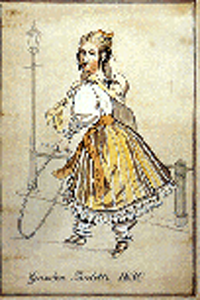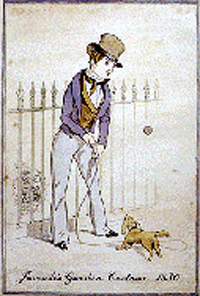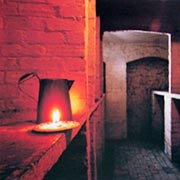Children
This research was done by Charlie Hodgson, on work experience from Midhurst Grammar School.
 The children would start their day being dressed by either their nanny or one of the servants, depending on their age. Very young boys would have been dressed in dresses, so it was very difficult to tell the difference between a very young girl or boy. As boys grew older they would wear knee breeches with a waistcoat and shirt with large cuffs. As girls grew older they would be dressed in more formal attire, possibly coupled with a pinafore or apron. They also often wore pantaloons which showed under their dresses.
The children would start their day being dressed by either their nanny or one of the servants, depending on their age. Very young boys would have been dressed in dresses, so it was very difficult to tell the difference between a very young girl or boy. As boys grew older they would wear knee breeches with a waistcoat and shirt with large cuffs. As girls grew older they would be dressed in more formal attire, possibly coupled with a pinafore or apron. They also often wore pantaloons which showed under their dresses.
From the early 1800s clothing more specific to children began to emerge, as opposed to children being dressed as small adults. From their early teenage years children would begin to be treated more as adults and they began to wear styles of clothes similar to their parents, they were also expected to behave as such.
After dressing, breakfast would be taken with their mother. Most fathers took a very small role in the child's upbringing. Children of upper class families would have had a nanny and often a governess who were responsible for a large part of the child's upbringing.
 After breakfast younger children would be looked after by the nanny and nursery maid and older children would go to their governess for lessons. Education was very important and a high level was achieved, with Latin and Greek being particular favourites. Lunch would usually be taken with their mother and would be followed by a nap for younger children. After their nap there would be time for more education, play and exercise. Children would be taken to the garden in the Square by their nanny and would be expected to behave at all times.
After breakfast younger children would be looked after by the nanny and nursery maid and older children would go to their governess for lessons. Education was very important and a high level was achieved, with Latin and Greek being particular favourites. Lunch would usually be taken with their mother and would be followed by a nap for younger children. After their nap there would be time for more education, play and exercise. Children would be taken to the garden in the Square by their nanny and would be expected to behave at all times.

The square originally had much higher railings than it does today and also had locked gates. This meant that only those who lived in the Square or Terrace had access, so a mother could be sure that her children would only meet the 'right kind of people' whilst in the square. In the evening the children would eat their meal earlier than their parents and would be put to bed before their mother and father had to prepare for dinner.
The code of social etiquette in Regency times was somewhat stricter than it is today. Upon greeting one's elders and betters a young lady would be expected to curtsey in either a grande tenue or a humble bob. Boys would uncover their heads as a sign of respect and as they grew into men would learn to bow and remove their hats with an elegant flourish. It was considered extremely impolite if any "yes" or "no" answer was not followed by "Sir", "M'lord" or "Madam". However, extracts taken from the letters of the Fourth Earl of Chesterfield, show that many faux pas are still recognised today!
A Child's day Life for a Regency child was a far cry from that of today's youngsters. From a very early age they would be groomed to be involved in the social world of their parents, learning good manners and etiquette and being highly educated.



